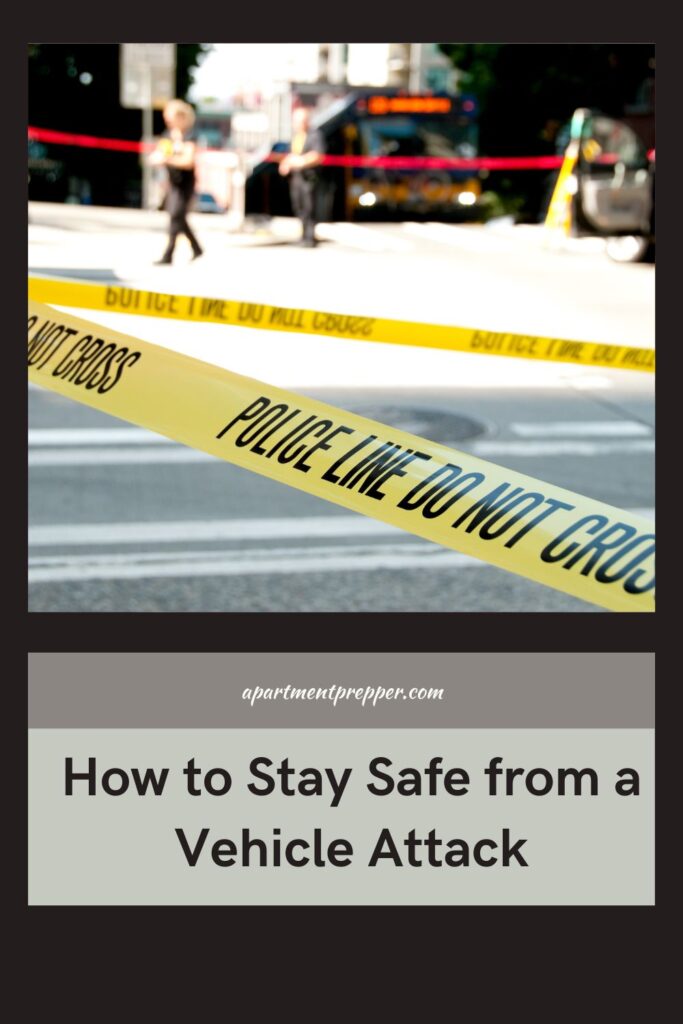Written by Bernie Carr
Everyone remembers what happened in New Orleans on New Year’s Day 2025 during the early morning, when a man drove a pickup truck into a crowd. Sadly, 14 people were killed and dozens were injured. Vehicle attacks—where vehicles are used as weapons—have become a serious concern in urban areas. How do you stay safe from a vehicle attack? This guide explains how to protect yourself and others, focusing on situational awareness, preparation, and effective response strategies. Read on to learn actionable tips for staying safe.
1. What Is a Vehicle Attack?
A vehicle attack occurs when a car, truck, or other vehicle is intentionally used to harm people. These incidents often take place in:
- Crowded Public Events: Parades, concerts, or festivals.
- Pedestrian Zones: Markets, shopping streets, or tourist areas.
- High-Profile Gatherings: Political rallies, protests, or large assemblies.
Attackers target crowded areas to cause maximum harm, so understanding these high-risk locations is crucial.
2. Stay Aware of Your Surroundings
Awareness is your first line of defense. Here’s how to stay alert:
- Look Around: Look all around you. Watch for unusual behavior or erratic vehicle movement. As you view your surroundings, identify possible areas where an attack could occur. Keep an eye on these areas.
- Know Your Exit Points: Always locate at least two safe escape routes when you enter a crowded space. Identify at least two safe areas that could offer protection, such as a building entrance, a heavy barrier, etc.
- Avoid Distractions: Limit phone use and stay engaged with your surroundings.
- Trust Your Gut: Listen to your instincts. If something feels wrong, act quickly to distance yourself from potential danger.
3. Recognize Warning Signs
Identifying potential threats early can save lives. Watch out for:
- Speeding Vehicles: Cars or trucks moving unusually fast in crowded areas.
- Oddly Parked Vehicles: Vehicles parked in unauthorized or suspicious locations.
- Driver Behavior: Drivers who seem agitated, distracted, or determined to break traffic rules.
4. Plan and Prepare for Safety
Preparation increases your chances of staying safe. Follow these tips:
- Choose Safer Routes: Avoid areas with limited escape routes or high pedestrian traffic when possible.
- Attend Secure Events: Opt for events with visible security measures like barriers or bollards.
- Stay Informed: Monitor local news for potential threats, especially during high-profile events.
- Carry Essentials: Keep a small first-aid kit and a fully charged phone handy.
- Hold on to Your Kids: If you have children with you, don’t let them go ahead or behind you. Hold on to their hands so you have them with you at all times.
5. How to React During a Vehicle Attack
If a vehicle attack happens, quick and decisive action can save lives:
Move Out of the Path
- Run Sideways: Move perpendicular to the vehicle’s path to escape faster.
- Find Cover: Use barriers like trees, poles, concrete structures, or parked cars to shield yourself. Get into a building if you can.
- Stay Alert for a Secondary Attack: Previous vehicle terror cases have shown that some attackers plan a secondary attack where they get out of the vehicle and start shooting or stabbing anyone around. Be on alert for additional attacks before getting out of your safe spot.
Help Others
- Alert People Nearby: Shout or signal to warn others of the danger.
- Assist Vulnerable Individuals: Help children, elderly individuals, or those with limited mobility get to safety.
Stay Focused
- Assess the Situation: Identify the safest escape route.
- Act Quickly: Avoid freezing or hesitating during an attack.
6. Assist Victims and Report the Incident
After an attack, bystanders can play a critical role:
- Call for Help: Contact emergency services immediately and provide detailed information about the situation.
- Provide First Aid: If trained, assist injured individuals while waiting for medical professionals.
- Guide Authorities: Help police and emergency responders locate the most affected areas.
7. Long-Term Preparedness Tips
Staying prepared for potential threats involves more than just immediate actions:
- Take Safety Training: Enroll in courses on personal safety and situational awareness.
- Spread Awareness: Share safety tips with friends and family.
- Support Safety Measures: Advocate for protective barriers and enhanced security in public spaces. Consider purchasing a couple of trauma kits, one for your car, and one you can carry with you. Hopefully, you’ll never need it, but it’s better to be prepared.
8. What to Do After an Attack
If you survive a vehicle attack, follow these steps:
- Move to Safety: Leave the attack area to avoid secondary threats.
- Report Details: Share observations, such as the vehicle’s description or the driver’s appearance, with authorities.
- Check for Injuries: Assess yourself and others for injuries and seek medical attention if needed.
- Seek Emotional Support: Reach out to a counselor or support group if the event was traumatic.
9. Promote a Culture of Vigilance
Preventing and mitigating vehicle attacks requires collective effort:
- Be Proactive: Report suspicious activities or vehicles to authorities.
- Support Training Programs: Advocate for community or workplace training on safety response.
- Engage with Local Authorities: Participate in discussions about public safety measures in your area.
Final Thoughts
Vehicle attacks have become sad reality, but staying informed and prepared can significantly reduce risks. By practicing situational awareness, recognizing warning signs, and knowing how to react, you can protect yourself and others. Remember, vigilance and preparation are the keys to staying safe in unpredictable situations.
We are an affiliate of Amazon.com, which means we received a small commission if you click through one of our Amazon links when you shop, at totally no cost to you. This helps keep the lights on at the blog. Thanks!
About the author
Bernie Carr is the founder of Apartment Prepper. She has written several books including the best-selling Prepper’s Pocket Guide, Jake and Miller’s Big Adventure, The Penny-Pinching Prepper and How to Prepare for Most Emergencies on a $50 a Month Budget. Bernie’s latest e-book, FRUGAL DIY has just been released on Amazon. Her work appears in sites such as the Allstate Blog and Clark.com, as well as print magazines such as Backwoods Survival Guide and Prepper Survival Guide. She has been featured in national publications such as Fox Business and Popular Mechanics. Learn more about Bernie here.
FB: https://www.facebook.com/apartmentprepper
Instagram: https://www.instagram.com/apartmentpreppers/
X (formerly Twitter): https://x.com/AptPrepper
YouTube: https://www.youtube.com/channel/UC7vOtdbo-wiBeBxD6puCr1Q
Patreon: https://patreon.com/apartmentprepper
Pinterest: https://www.pinterest.com/aptprepper/
Today’s societal climate not supportive of prepping. With your help, we can keep bringing you content th
Join me on Patreon for ad-free content.



